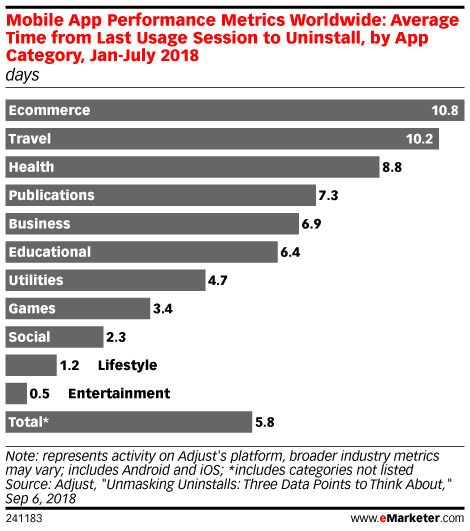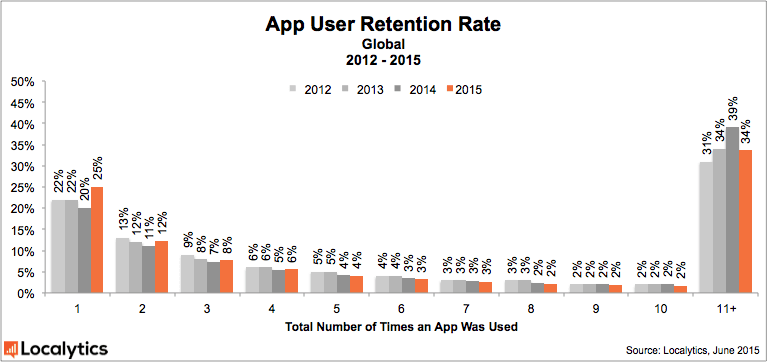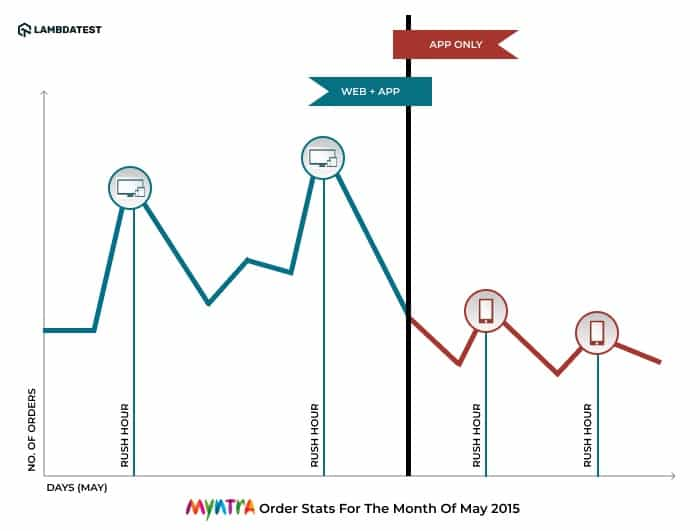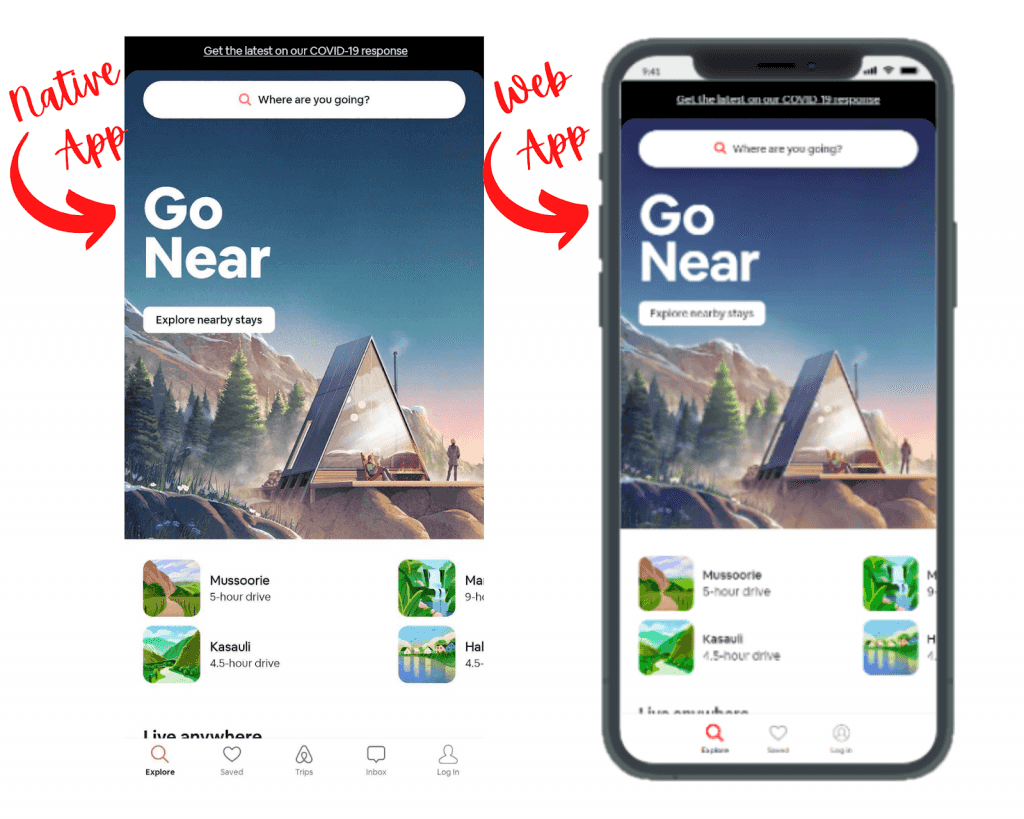Mobile App Vs. Mobile Web: A Comprehensive Comparison
Kritika Murari
Posted On: February 12, 2021
![]() 9681 Views
9681 Views
![]() 12 Min Read
12 Min Read
“57% of mobile app users churn and no longer use the app one month after they downloaded it.” – Localytics
In the past couple of years, mobile devices have taken over the consumer world. However, in a recent survey conducted by Localytics, it was found that the consumers’ behavior is different while using a mobile app and mobile web. It is a common misconception that consumers automatically prefer apps over mobile websites. The reality is that mobile consumers are driven by need and convenience, regardless of what platform they use.
Adjust analyzed 8 billion app installations worldwide and discovered that apps get deleted 5.8 days after they’re last used on an average. Mobile apps achieve half of their lifetime usage in the first six months. Then it’s all downhill from there.

Abandonment among app users tends to be exceptionally high, especially for a relatively new business fighting against the odds. A rapidly rising app fatigue makes it harder to manage churns, decreasing retention rates and adding to app makers’ worries. Within three days of being installed, the average app loses 77% of its daily active users. Within 30 days, this number increases to 90%. Within 90 days, this number reaches up to a staggering 95%.
If mobile apps make it so much harder to make profits, why are so many businesses abandoning the mobile web?

App developers may have a chance to work their magic, but the reality leans toward the mobile web. For a much more significant effort, businesses see less than a third of the conversions from apps than they see from mobile websites. Additionally, designing a mobile app may be a massive investment for budding businesses. In comparison, building a tremendous mobile-friendly website may be much more affordable.
If you already have a mobile app but with high churn rates, remarketing might not be an easy option here. The process of retargeting former app owners and ensuring they reinstall is far more complex than having a user revisit your website. Retargeting techniques such as push notifications aiming to get users to open preinstalled apps also tend to fall on deaf ears.
An analysis by BizRate shows that 19% of people are shopping on mobile-optimized websites, while only 3.6% of shoppers download shopping apps.
With more than 50% of the global traffic coming in from the mobile web, creating memorable mobile web experiences is more scalable for business. There are numerous cases of companies skyrocketing after redesigning their mobile websites. Jumia, a leading e-commerce website in Africa, decided to deliver an app-like experience to its users with a PWA (progressive web app). Their PWA was built integrated across functions and resulted in a 33% higher conversion rate. Additionally, they saw a decline of 50% in their bounce rates and 12 times more users than native mobile apps. Lancôme is another success story of successfully optimizing their website for mobiles and driving conversions by 17%.
So the question is, should you restrict your mobile audience to apps only? Or should you rather focus on optimizing a mobile-friendly web experience.?
To help you make the best decision for your business, we will dive deep into the entire saga of mobile app vs. mobile web. We will find out how a mobile-app only approach affects businesses.
How Mobile-App Strategy Fares For Businesses
Flipkart and Myntra, two of India’s leading eCommerce platforms, grabbed many eyeballs in 2016 by announcing an app-only model. They claimed to be the very first web-based platforms in the world to adopt an app-only route. While this news did get them much attention worldwide, the mobile app-only strategy did not pan out so well. Flipkart lost its lead in the e-Commerce market, and Myntra saw a dip of 10% in its sales.
As soon as Flipkart announced its app-only strategy, its global rival Amazon started rolling in the hay. This provided them with the perfect opportunity to gain the upper hand and get ahead in the game. And that’s what happened! Flipkart’s sales started dropping down (though they never accepted it), and Amazon’s business boomed up. While Flipkart was busy fiddling with its mobile-app only strategy, Amazon became the top eCommerce platform in India. This happened although Flipkart was founded in 2007, while Amazon came into India in 2013.
Amazon even went on to issue full-page advertisements in newspapers, thanking their customers for making it the most visited e-commerce site in India!
Peeyush Ranjan, then Engineering Head at Flipkart, said that going app-only was not a wise decision. Here’s what he had to say, “Apps also have their weaknesses. You have to download them, and you have to keep updating. Our mobile web app offers the benefits and superior experience of the app without the limitations. We will get a bunch of new users through the mobile web who don’t have our app installed.”
The apple didn’t fall far from the tree. Myntra suffered the same fate. It started losing many users who preferred to shop on a browser rather than an app.
Here’s how Myntra’s sales were affected after the app-only launch.

“Cutting off a channel doesn’t make sense unless the channel costs were exceeding benefits or the use of that channel was resulting in wrong positioning. Myntra’s app-only strategy certainly got them some media attention but didn’t seem to have served a business purpose.” – Rishikesha T Krishnan, Director of Indian Institute of Management Bangalore. Source (Knowledge@Wharton)
Initially, the founders were committed to the app-only strategy. They were confident that the mobile website would push users towards the app. Here’s what happened instead- within a few months, both the platforms backtracked on their decisions. Flipkart soon launched a ‘lite’ version of its website, and Myntra relaunched its mobile website.
Before the app-only fiasco, Flipkart specifically partnered with Google to build a mobile website for Google Chrome. They wanted to replicate the features of its app and retain the benefit of the mobile web view. This was how Flipkart tried to make up for the lost revenue. Since the website relaunch, Myntra’s mobile website gets an average of 1.5 million daily mobile web visits. Additionally, their website’s average time spent went up from less than a minute to five minutes or more.
Mobile web app was the winner at the end of the day!
Reasons Why Mobile-App Only Strategy Can Fail You
Shutting down a website and going the app-only way is now considered the ‘most consumer-unfriendly idea’ and rightfully so. By having a user-friendly website, you cater to an ever-growing number of smartphone users and take care of desktop users. By going the app-only way, you are simply neglecting the masses who may not have the smartphone capable of running multiple apps at a time. There are numerous reasons why the mobile app-only strategy is bound to fail.
Minimal Reach
Mobile is the dominant medium of consumption. As a user, how many times do you transact with an e-commerce app or any app in general? If you think about it, an average user doesn’t transact more than a couple of times a month on an app. They are bound to open up a website first, explore your products, and consider installing your mobile app. You cannot expect a user to change their behavior simply to access your mobile app.
According to Statista, more than 100,000 new Android apps and 30,000 new iOS apps are released in the Google Play Store and Apple App Store every month. This makes it harder for you to reach a wider audience. You cannot expect them to install a separate app for every new product they come across. A mobile-friendly web app is an easier way to reach them.
Limited Engagement
There are two reasons why engagement is expected to over-index on Smartphones: the presence of an app’s shortcut on the user’s home screen and push notifications. Businesses often assume that engagement is a given once a user has installed their app, yet that’s not the case. You might be sending out 3-4 push notifications every day, but the conversion efficiency might be dropping down. They don’t realize that firstly, the mobile app might be taking up extra storage space, and the user might decide to free up that space any day. Secondly, push notifications might irritate users and can even be considered spam by smart wearables like an Apple watch, thus completely blocking them.
A more innovative way to approach this is by encouraging users to get on your web app and ensuring that they see the best version of your web app. In 2015, Cleartrip redesigned its mobile website. The idea behind this redesign was to provide a consistent experience across desktop and mobile web. Simply put, the mobile web is one of the fastest and easiest ways to reach your potential customers. Without taking on the arduous task of developing a mobile app, all you need to do is maintain an excellent mobile user experience.
Slashed Conversions
Innovation is always the way to move ahead of the competition. But innovation must be driven by putting the consumer first. You must go where the customer is. You must make your business flexible enough for them to buy anywhere, anytime, and on any platform or device. But, a mobile app can be a huge hindrance when it comes to converting those customers.
Factoring in Customer Acquisition Cost (CAC), the cost of convincing a potential customer to browse your website & potential make a purchase is very different from convincing a customer to install a mobile app & then make a purchase. It is much easier to get a user on your website than installing your app.
The lion’s share of new smartphone users will always come from your website, and they will convert only if have a mobile friendly website. Otherwise, you might end up losing them forever.
“Although an app-only approach might be a fit for certain unique business models, the majority of businesses would not be served well going that route.” – Tom Nawara, The VP of Acquity Group (Source: MarketingDive)
Overreaching Development Efforts
Mobile apps need to be built for specific platforms, be it iOS or Android. This means building each app from scratch requiring significant development efforts. They live and run on the device itself and need constant updating and maintenance to keep bugs at bay. All this amounts to a significant overhead for your business. Even if you make it so far, it may turn out to be quite a challenge to get your app approved by app stores.
On the other hand, web apps can be accessed via any mobile device with a browser installed. They don’t have to be downloaded or installed. They can automatically adapt to the user’s device, given that you take care of cross browser compatibility. Regardless of the platform a web app is accessed on, the codebase is standard, making it easier to build and update. You don’t even have to wait for any approval. You build it; you launch it.
If appropriately designed, web apps can be made to look and feel like a native mobile app. Take a look at Airbnb’s native and web app. They might be two different products, but they are almost the same and can give the same excellent results!

Laborious Web Testing
Testing a mobile app is way more complicated than testing a web app. From hiring specialists to investing more in the infrastructure, mobile app testing can sum up to a massive overhead for your business. That’s not even considering the general maintenance of a mobile app.
On the other hand, testing a web app or a mobile-friendly website is much simpler and achievable. Instead of investing a lot, you can simply go for cloud testing and check how your web app performs across a plethora of browsers or devices. LT Browser is one such browser for developers that allows you to build and test the responsiveness of your website or web-app across 50+ devices.
Mobile Web App Trumps All!
It is time to acknowledge that mobile web apps have a significant impact on your business. Instead of focusing on the technicalities, brands should focus on creating value for their users. Users who are on their mobile for most of their day. Users who want to browse and shop but might try to avoid installing an app for doing so.
After all this, Myntra still managed to increase its user engagement by going back to its website. According to Techniasia, 68 percent of Myntra’s customers are now viewing the site on mobile. You can do it too and more successfully!
“Even if the mobile-only strategy didn’t work, I suspect that mobile-first is still the way to go.” – Kartik Hosanagar, Professor of Technology and Digital Business at the Wharton School. Source (Knowledge@Wharton)
So what are you waiting for? Start creating a mobile-first web design right away with the LT Browser!
Got Questions? Drop them on LambdaTest Community. Visit now










